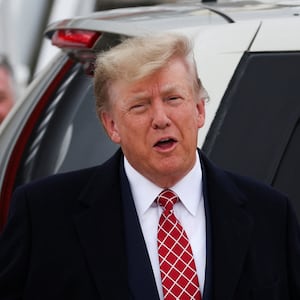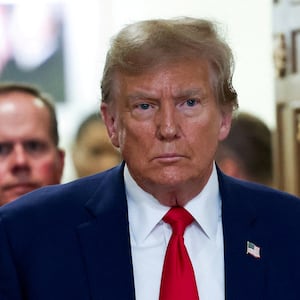Donald Trump is working hard to get an appeal of the $464 million judgment levied against him for committing bank fraud. But if he does fork over the cash and get that appeal, he may find that it doesn’t take the higher courts long to swat it down.
That’s because the 92-page opinion issued by New York Supreme Court Justice Arthur F. Engoron was tailor-made to withstand appeal—and give the state’s First Judicial Department a roadmap to uphold the decision.
“The reason why this opinion is so long and so specific is to emphasize to the appellate court how much care the judge took in issuing this decision,” said Jennifer B. Arlin, an expert on appeals who teaches legal writing at Brooklyn Law School.
A review of the judgment demonstrates that it was structured in an unusual format, one that dedicates a disproportionate amount of space to analyzing the facts presented during the 11-week trial—and provides a simple guide for an appellate court to quickly examine it, understand the judge’s reasoning process, and come to a swift decision.
“It's so well laid out that it says, ‘Go ahead—challenge me,’” said Diane Peress, a former prosecutor who now teaches at John Jay College of Criminal Justice. “I think it's very smartly done, because it really shows that he didn’t just say, ‘Hey, half a billion dollars, whatever.’ It shows that he based it on fact, on law.”
All court orders lay out what are called “findings of fact” and “conclusions of law,” a combination that explains how and why a judge issued a decision. For example, Colorado Judge Sarah B. Wallace’s “findings of fact” took up exactly a third of her November order that concluded Trump engaged in insurrection but should be kept on the 2024 ballot—an order that was later overturned and is now under consideration by the Supreme Court.
By contrast, Engoron’s “findings of fact” about Trump’s bank fraud stretch on for 68 pages, taking up more than two-thirds of this opinion. In that space, the court lists 39 witnesses, explaining their testimony in detail and even offering acerbic commentary about their credibility. Engoron’s order particularly tears apart the integrity of former Trump Organization controller Jeffrey McConney, noting how “he obfuscated and equivocated at length before finally conceding” details about his role in the ploy to shed blame over to outside accountants for lying to banks. The judge’s decision also notes how a tenured professor at New York University clocked $877,500 to offer expert testimony about financial accounting—only to ignore “numerous significant errors” in Trump’s personal financial statements, repeating the “unpersuasive” performance he gave at another major trial involving the oil giant Exxon Mobil.
“By doggedly attempting to justify every misstatement, Professor Bartov lost all credibility in the eyes of the court,” the order says.
That means appellate judges can get a clear sense of the trial by reading through Engoron’s retelling—without having to peruse the 6,758-page trial transcript. They can rely on the observations of Engoron and his law clerk, Allison Greenfield, who sat by the judge during the entire trial.
“This court listened carefully to every witness, every question, every answer. Witnesses testified from the witness stand, approximately a yard from the court, who was thus able to observe expressions, demeanor, and body language. The court has also considered the simple touchstones of self-interest and other motives, common sense, and overall veracity,” Engoron’s order says.
This laser-like focus on the witnesses and their reliability is actually a conscious and meticulous effort to build a case that will stand up on appeal, legal scholars said.
Arlin noted that appellate courts will look at the order through a specific lens called the standard of review. Higher court judges can thoroughly examine Engoron’s legal conclusions, but they have to defer to his findings of fact—particularly when the trial was his decision and his alone. There was no jury; Trump never asked for one formally.
“The very detailed listings of the ‘findings of fact’ are on purpose,” Arlin said. “The trial court is in a unique position to not only hear the testimony and look at the evidence, but as he said very explicitly, he was able to see the facial expressions and attitudes and eye contact.”
“He went out of his way to say he was just a few feet away when they were testifying. He's the judge of the credibility of the witnesses,” Arlin continued. “The appellate courts have to rely on the trial court's assessment of credibility, and that was a huge issue in this case. He found that these people were clearly lying and lacked credibility.”
While it’s normal for judges to cite witness testimony, it’s exceedingly rare for a court’s order to provide a list of Dramatis Personae and comb through their statements. Engoron’s order listed all but one of the entire trial’s 40 witnesses. The court took 37 days to issue the judgment after closing arguments in January.
“It is unusual, yes. But we're dealing with an unusual defendant and the armies of lawyers he's going to employ who are going to leave no stone unturned,” Peress said, stressing that Engoron is “trying to make it bulletproof.”
An appellate court can only overturn Engoron’s fact findings if he was in what’s deemed “clear error,” hence the more detailed approach to listing every aspect of the case. The judgment also reviewed 10 different Trump properties and the fraud that took place in each one, and separately examined eight instances of fraud.
The next move in this chess game is Trump’s to make. First Judicial Department Judge Anil Singh on Wednesday temporarily stopped the bulk of Engoron’s judgment, which submits the Trump Organization to severe scrutiny going forward, and ejects the fraudsters from the business world—including the real estate tycoon, his sons Don Jr. and Eric, and former company chief financial officer Allen Weisselberg.
But the appellate judge refused Trump’s low-ball $100 million offer to stay the execution of the full judgment, meaning that New York Attorney General Letitia James next month could begin aggressively moving to seize his assets to satisfy the outstanding half-billion-dollar bill.
In mid-March, Engoron can greenlight the AG forcefully grabbing Trump brand properties and putting them up for auction. It's looking increasingly likely that Trump will actually have to come up with the money anyway to stop that. New York appellate bond rules require that he front 110 percent to 120 percent of the judgment, a massive sum he doesn't appear to have, especially now that he also owes $83 million for losing his second rape defamation case in January.
But legal observers are particularly interested in what happens if Trump continues with his appeal without trying to stay the execution of the judgment—an awkward scenario in which the AG seizes a Trump building or golf course even as he fights the legal battle in higher courts.
Either way, Trump faces a stark deadline in late March, just days before he starts his very first criminal trial against the Manhattan District Attorney on March 25.









